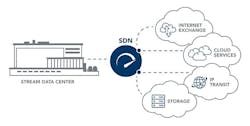Bringing Cloud Connectivity Up to Speed With Business Priorities
In this edition of Voices of the Industry, cloud interconnection expert Eric Ballard of Stream Data Centers discusses the shortcomings of legacy cloud solutions — and the advantages that innovative SDN partners can bring to cloud data centers and their customers.
Eric Ballard is Vice President, Network and Cloud Services, Stream Data Centers.
One of the most compelling benefits of cloud connectivity is the ease with which businesses are able to tap into ever-evolving software, services and industry platforms. The cloud offers a level of scalability and flexibility that’s unmatched by legacy networking solutions. But here’s the problem: All too often, connecting to the cloud in the first place is harder than it should be.
Old ways of connecting may require frequent and costly hardware investments, ongoing in-house administration, long-term contracts with bandwidth limits, and countless other frustrations. Fortunately, forward-thinking cloud centers are offering new solutions that eliminate these roadblocks — while bypassing the internet and ensuring cost-effective scalability. Let’s take a look at three approaches to cloud interconnection, including a next-generation solution that combines the reliability of a proven data center with the adaptability of software-defined networking (SDN).
1: Reinventing the wheel with a do-it-yourself solution
For most organizations, a do-it-yourself connection to big cloud providers involves more time, money and uncertainty than it’s worth.
The process begins with purchasing a circuit to connect an enterprise’s IT infrastructure to a cloud provider — a pricey proposition for organizations that don’t buy this technology regularly. The installation and testing of the system can also be costly, creating liability risks if something goes wrong or if it can’t pass an audit.
Enterprises must repeat this process for each additional cloud provider they connect to. This adds cost, hassle and significant risk. Using a traditional network operator also means signing long-term contracts for services like connectivity, power and security. Aside from being expensive, these arrangements can be rigid and thus act as constraints to an organization’s growth.
2: Assuming big providers have the cloud all figured out
There’s a good chance that your existing service provider will promise to solve your cloud connectivity issues. But the reality is that big providers can create more problems than they solve, due to the retrofit nature of these implementations. Establishing network connections can take months, and vendors typically do not offer service level agreements, which set expectations for the types and quality of service as well as remedies for failure to meet them.
In addition, networking infrastructure can vary from one geographic market to the next, and businesses may need separate interconnections for each location where they have mission-critical hardware. Also, since third-party firms typically have physical interconnections only in the largest metropolitan areas, the high costs of overhead and labor are passed on to their customers. These carriers also typically require long-term contracts, which force enterprises to either pay for bandwidth they’re not using, or to make cumbersome changes when private interconnections like virtual private networks push them unexpectedly over bandwidth limits.
3: Keeping it simple — by adopting an advanced strategy
As an industry executive in charge of networking and cloud operations, it’s my job to help customers keep up with the ever-changing IT demands of cloud-based business platforms like Amazon Web Services, Microsoft Azure, Salesforce.com, Google, Oracle and IBM Cloud. And in my experience, direct cloud interconnection through a strategically located data center is the one solution that offers customers the flexibility they need in three key areas: utilization, economy, and geography.
As enterprises adopt increasingly computing-intensive workloads, such as cloud-based applications and artificial intelligence, we expect them to take advantage of even more IT resources through the cloud.
In the case of Stream Data Centers, we chose to partner with Megaport for their robust and highly adaptable cloud interconnection offerings and global interconnection points.
From a utilization standpoint, customers are able to establish virtual cross-connects quickly, and bandwidth is readily available. They also have the flexibility to turn services on and off as needed. From an economic perspective, customers pay only for the services used and the bandwidth consumed, which makes good sense for businesses at every stage of growth. And in terms of geography, solutions like these can open up new options in markets that previously have never had this level of access, including Minneapolis, San Antonio and Houston.
Direct cloud interconnection can work well for companies of all sizes. As we’ve seen at Stream, our cloud interconnection SDN partner has made it possible for us to serve customers with a broad range of needs — from large enterprises with fairly limited cloud utilization, to small start-ups whose cloud presence is both sizable and sophisticated. These frequently include cloud providers themselves, who host their infrastructure from one of our data centers.
Unpacking the benefits of direct, elastic cloud connectivity
From straightforward email and digital storage needs to highly specialized sales and marketing platforms, cloud strategies that leverage direct, elastic connectivity offer superior advantages to traditional cloud networks. These include:
- Real-time scalability — adding or subtracting bandwidth and services to suit immediate needs
- Seamless integration — managing multiple resources through a single portal, app or API stack
- Cost savings — avoiding unnecessary charges for bandwidth or services not used
- Time savings — allowing IT staff to focus on mission-critical tasks, versus do-it-yourself cloud solutions
- Enhanced performance — bypassing the internet to leverage a true dedicated connection for speed, security and reliability
A flexible cloud framework for whatever comes next
As enterprises adopt increasingly computing-intensive workloads, such as cloud-based applications and artificial intelligence, we expect them to take advantage of even more IT resources through the cloud. And, while no one can be sure what the next cloud service will be, having a flexible cloud network solution in place within a future-focused data center can help organizations stay nimble and efficient as new opportunities emerge.
Eric Ballard is Vice President, Network and Cloud Services, Stream Data Centers.





